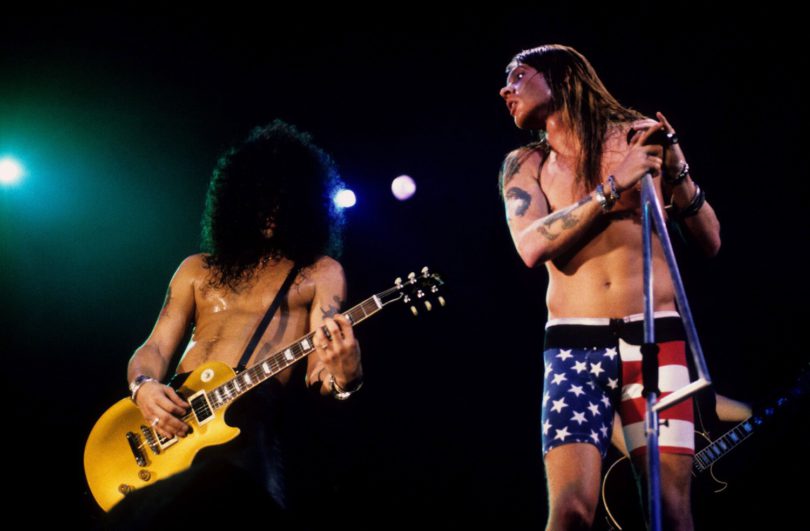Rock music has often thrived on rebellion—against social norms, against musical traditions, even against time limits. While most radio hits stick close to the three-to-four-minute formula, some bands and artists have boldly stretched their songs into sprawling epics. These longer tracks don’t just defy convention; they create immersive worlds where lyrics, instruments, and emotions can unfold without hurry. Three classics—Guns N’ Roses’ “November Rain,” Bob Dylan’s “Desolation Row,” and Led Zeppelin’s “Stairway to Heaven”—show why the long-form rock song continues to captivate listeners decades after its release.
Guns N’ Roses and the Drama of “November Rain”
By the early 1990s, Guns N’ Roses had become the poster children for rock and roll excess. Their Use Your Illusion era was marked by outsized tours, ballooning budgets, and a reputation for indulgence in everything from substances to stage theatrics. Yet in the middle of this chaos emerged one of the most ambitious rock ballads of the time: “November Rain.”
Running nearly nine minutes, the track blends hard rock with symphonic drama. Its orchestral arrangements, sweeping piano lines, and Slash’s soaring guitar solos elevated the song from a power ballad into something almost cinematic. The grand finale—a baroque-inspired outro paired with Slash’s fiery second solo—feels more like the climax of an opera than a rock single.
Axl Rose’s commanding presence was key to bringing such a risky project to life. Many bands would have balked at attempting something so complex, but Rose’s relentless drive and perfectionism helped push “November Rain” into reality. Even the music video became legendary, with a helicopter-filmed wedding scene that reportedly cost over $1.5 million, making it one of the most expensive videos of its time. The gamble paid off—the song remains a staple on classic rock radio and a defining moment in the band’s career.
Bob Dylan’s “Desolation Row”: Poetry Without Borders
If “November Rain” is an example of rock’s grand theatricality, Bob Dylan’s “Desolation Row” demonstrates how long songs can captivate with nothing more than words, voice, and guitar. Released in 1965 on the Highway 61 Revisited album, this 11-minute masterpiece eschews choruses, flashy solos, and elaborate arrangements. Instead, Dylan strings together ten verses of surreal, vivid imagery that create a dreamlike portrait of society’s fringes.
Characters both mythical and historical wander through the song—Cinderella, Romeo, Cain and Abel, Einstein dressed like Robin Hood, even the feuding poets Ezra Pound and T.S. Eliot. Each verse feels like a short story, painting a fragmented yet strangely cohesive picture of a world in disarray. What holds it all together is Dylan’s hypnotic vocal delivery and the song’s refrain, the haunting line that returns again and again: “They’re selling postcards of the hanging / They’re painting the passports brown … Welcome to Desolation Row.”
At over 11 minutes, the track challenges the attention span of casual listeners, but for those willing to surrender to its rhythm, it’s a journey unlike any other. Dylan showed that a long song need not be bloated or self-indulgent—it could be an act of pure lyrical artistry.
Led Zeppelin’s “Stairway to Heaven”: The Ultimate Rock Epic
Few songs in rock history carry the same aura as “Stairway to Heaven.” At just over eight minutes, it’s not even the longest track in Led Zeppelin’s catalog, yet it has become the gold standard for what a long-form rock song can achieve.
The magic lies in its structure. The song begins quietly, with delicate acoustic guitar and recorder, evoking a medieval or folk atmosphere. Gradually, layers build—vocals gain intensity, electric guitars enter, and the rhythm swells—until the track explodes into one of the most iconic guitar solos ever recorded. The finale is pure catharsis: Robert Plant’s soaring vocals, Jimmy Page’s blistering guitar, and John Bonham’s thunderous drumming bring the piece to an electrifying close.
“Stairway to Heaven” isn’t just a song—it’s a journey. Listeners are pulled through moods of calm reflection, mounting tension, and ecstatic release. The track has been interpreted endlessly, its cryptic lyrics inspiring debates about spirituality, materialism, and mysticism. But at its core, it proved that rock music could aspire to the same grand narrative arcs as symphonies or operas.
Why Long Songs Still Matter
In an age dominated by streaming platforms, short attention spans, and TikTok-ready snippets, one might assume that long rock songs have little place. Yet tracks like “November Rain,” “Desolation Row,” and “Stairway to Heaven” remind us that music doesn’t always have to be bite-sized. Sometimes, the magic lies in the stretch of time, in letting an idea breathe and evolve.
These epics ask listeners for patience but reward them with immersion. They prove that songs can be more than background noise—they can be events, experiences to lose yourself in. From Axl Rose’s theatrics to Dylan’s poetic vision to Zeppelin’s layered masterpiece, these artists showed that breaking free from the three-minute mold can produce timeless results.
Rock’s great long songs endure because they invite us into a world where music is not just consumed, but lived. And in a culture that often feels rushed, there’s something profoundly satisfying about surrendering eight, nine, or even eleven minutes to a piece of music that refuses to be hurried.

